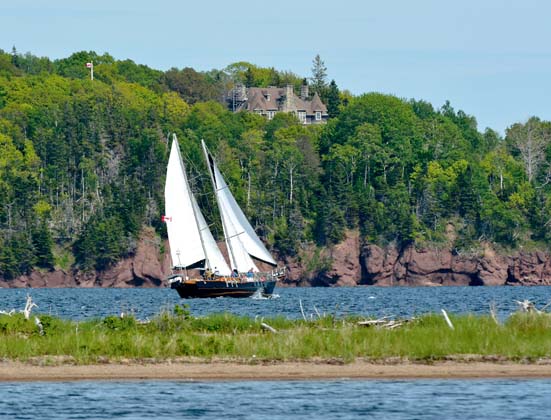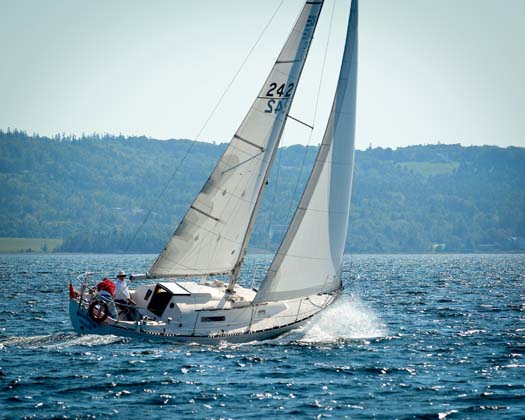At the north end of Nova Scotia, Bras d’Or Lake was a welcome respite from the wild Newfoundland coast for Tom Zydler
Our Mason 44, Frances B, on the run from ever-colder climes farther north, swept by Cape Anguille at the tip of St George Bay on the south-west coast of Newfoundland. Over the past few hours the seas had got steeper, but we were happy with our progress through an area where south winds prevail. Already the stiff but fair north-easterly was forecast to back to the south-west soon.
We were approaching Cabot Strait between Newfoundland and Cape Breton Island. The mighty St Lawrence River runs towards the Atlantic through the Strait. Add conflicting tidal streams on top of contrary swells and you end up with a nasty piece of water. Still we decided to press on. Every mile gained southward brought us closer to the shores of Cape Breton Island and, beckoning within it, the Bras d’Or Lake, an oasis of calm in the western North Atlantic.
The next evening the seas and wind dropped signalling a change in the weather. The engine rattled into life to keep up our speed. I checked the current tables for Great Bras d’Or Channel, a bottleneck where, on the ebb, the inland waters race seaward at astonishing velocity.

Luck was with us – Frances B entered the Channel in dead calm against a weakening tidal stream. While the dawn light lit up the high, steep slopes on the starboard hand our thoughts focused on finding an anchorage peaceful enough for catching up on sleep after three nights of watchkeeping, two hours on, two off.
Big Harbour
A few miles farther on a couple of house roofs flashed red through the green of the forest, the sign of our approach to Big Harbour, a tight inlet snaking into the hillsides. A large home and a timber wharf appeared just inside, symbols of slow change creeping into this silent countryside since our visit a few years back. It was late September and no one disturbed the pool of deeper water under a bluff of white gypsum.
Suddenly, silently, a bald eagle plummeted feet first and rose towards the tree tops with a fish in its talons. Minute ripples, the only evidence of the drama, spread out, shattering the mirror of calm water around the boat.
Our slumbers over we weighed anchor and turned south again in the Great Bras d’Or Channel. Shockingly, a ship was on the move northward to the exit from the Lakes; earlier in the dim pre-dawn light the passage appeared barely wide enough for Frances B. But bulk carriers do come here to load gypsum from a plant up St Patrick’s Channel, one of the arms of the large body of water jointly named Bras d’Or Lake.

A diagonal NE/SW line along the lake measures roughly 45 nautical miles. The main channel from the Atlantic begins at the Great Bras d’Or Channel we were sailing on. To the east and parallel to it stretches St Andrew’s Channel and south of the constriction at Iona and Barra Strait you can explore for days in East and West Bay.
At Red Head, a striking bluff of maroon rock, we turned west and into the wind. A white lighthouse, its top fire-truck red, a church spire, white homes, then yacht masts marked Baddeck, the main town on the Lakes. This welcome sight promised crops of fresh apples and pears, ample groceries, restaurants, internet, all the trappings of civilisation absent in Labrador where we had been.

Even the water was warm enough to jump in to inspect how much antifouling we had lost after an encounter with poorly charted rocks in the remote north. Baddeck Bay offered a break after the wild autumnal ride southward from Labrador and Newfoundland.
Remembering Alexander Graham Bell
A modernistic, domed structure stands conspicuously on a hill overlooking the anchorage: the Alexander Graham Bell Museum. Bell, one of the 19th Century’s geniuses of invention, together with Edison and Marconi, launched the age of instant personal communications.
Few of the hotshots skimming around on hydrofoils realise that Bell also successfully applied hydrofoil theory to water craft at the dawn of 20th Century. There is also a connection to cruising. In 1917 he had a 55ft yawl built for his daughter and her husband, Gilbert Grosvenor, the editor of National Geographic, a publication inspired by Bell, too. On that yawl, named Elsie, Bell presided at a meeting that led to the founding of the still active and influential Cruising Club of America.
The inventor’s spirit lingers in the area. From our anchorage between the wharf and Kidston Island, across the outer wide channel, in a forest grove high above the sea looms Beinn Bhreagh, the Bell family mansion.

The Bras d’Or Lakes enjoy gentle weather: good sailing summer breezes, and fog, such a pest offshore, rarely occurs here. The protection in Baddeck Harbour is similarly excellent. Only powerful north-easterly winds associated with a chance tropical storm spinning offshore towards Newfoundland may disturb the anchorage.
And sure enough one autumn day we had to bolt to a hurricane hole some five miles away in Washabuck River. Another boat already at anchor there was Iron Bark II, with Trevor Robertson, a Blue Water Medal recipient, who likes sailing in Atlantic Canada between his bouts of extreme cruising, which had included wintering in the icy latitudes of Greenland and Antarctica. Whether it blew hard in Baddeck we had no idea while listening to his adventures snuggled in Deep Cove, an almost landlocked side pond.
Finding shelter
On the way south again we had to cross the main extent of Bras d’Or Lake, but pounding to windward into 15 miles of chop didn’t seem like pleasure cruising. We chose instead a beat of five miles in smooth water to Maskell’s Harbour, where behind a hook of a grassy sandbar Frances B sheltered with a flock of brown ducks busily nibbling underwater grasses.
A swing bridge crosses the shores of Barra Strait, the funnel-shaped northern door into the main body of Bras d’Or Lake. The bridge tenders must be sailors themselves – the span always swings in perfect sync with the boat’s speed. Frances B shot through, the lake opened up and the boat rolled on gently in a westerly wind.
The lake’s shores to the west branch into West Bay, scalloped into numerous bays. Little Harbour on the Malagawatch peninsula is a good example. A skinny thread of deep water let us into a spacious bay bordered by forests. A massive log cabin, somewhat Alpine in character, overlooked the shore: Cape Breton Smokehouse, a lodge with a popular restaurant.

View Seal Island lighthouse Seal Island Bridge
Some years ago, the owners sailed into this bay after leaving Germany for a circumnavigation and fell in love with this sparsely populated land of forests, mountains and villages. Sharing the ownership with a local person, the couple can still make winter cruises south in their very seaworthy-looking black ketch at anchor in the bay.
The famed Bell family’s Elsie changed ownership a few times and the latest owner apparently had her totally rebuilt in West Bay village at the end of the large Bay. It sounded like an interesting place, in the past known for its shipbuilding. In the days before St Peter’s canal opened the southern access to Bras d’Or Lake, West Bay acted as an important trans-shipment port for people searching farther north for better lives and employment.

Bald eagle – flying
The wind was fair and Frances B was soon anchored just outside a small bay looking a bit too tight to enter. At close quarters it became obvious that West Bay’s glory days were history. The harbour has silted too much for deeper vessels.
Glorious sail
In autumn the weather systems at this latitude move fast. By the time we left West Bay the wind had backed to the south-west, a gift of a glorious sail in the lee of the high land of South Mountain peninsula. At Cape George, the southern limit of Bras d’Or Lake, the wind intensified from dead ahead, the land closed in and we had to power the few winding miles to Daminion’s Cove to wait for a north-west wind, a powerhouse when sailing south from the inland sea of Cape Breton Island to Nova Scotia.
In 1869 a canal was finally cut through the ancient canoe haul-over at St Peter’s village at the south-eastern end of the island. The Bras d’Or Lakes have tidal ranges measured in centimetres, while outside in Chedabucto Bay they reach 1.7m. A lock is necessary. Over 91m long, 14.5m wide and 4.8m deep it certainly left enough room for us to feel relaxed. About three-quarters of a mile before the lock high-voltage power lines cross a really tight turn in the channel, although at 27m above the water they didn’t threaten our modest mast.

A marina with several slips for visiting yachts opened up in a bay to starboard just before the lock approach. Blistering wind funnelled out of there so we brought Frances B alongside the bulkhead dockage leading into the canal proper, perfectly calm in the lee of tall trees. A short walk across the bridge over the canal (it swings open to let boats into the lock) took us to a forested trail and a hill that looks south towards Chedabucto Bay.
It also opened a clear view onto a seascape of an unrelenting stampede of whitecaps. Clearly coffee and cinnamon buns in downtown St Peter’s village were a better choice.

Next morning Frances B went through the lock and sailed on in a moderate north-westerly. As Cape Breton Island faded astern I tried to work out how many Bras d’Or anchorages still remained to be explored in future. Even though only the ones with overall protection qualified I gave up counting at 30, satisfied that we needed a few more years in the area.
Yacht facilities in Bras d’Or Lake
Baddeck is the main urban centre. Baddeck Marine offers moorings and floating docks, a very complete chandlery as well as engine and rigging services. An ample town wharf is deep and long enough even for very large vessels. Cape Breton Boatyard, well equipped with moorings, float slips, a railway haulout, storage sheds and the sheers for handling large masts may be closing down. Call ahead to obtain service.
Baddeck Marine – 902-295-2434. www.baddeckmarine.com
Cape Breton Boatyard – 902-295-2664. henryweldfuller@gmail.com
Ben Eoin Marina in East Bay – 902-828-1099, www.beneoin marina.com
St Peter’s Marina – 902-535-2729, www.st-peters-marina.com. St Peter’s Canal and lock open for service June-Sept, Thursday to Monday, call 902-535-2118 or on VHF Ch 10 to confirm passage and have the bridge across the canal opened.

Tom Zydler is a marine author and photographer, who has written many articles and cruising guides. He and his wife Nancy sailed round the world via South America and Antarctica




